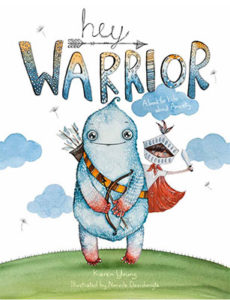Book Review: HEY WARRIOR
 Adoption is a lifelong journey. And sometimes it feels like anxiety is, too. In our work at BPAR we find that one of the most common feelings that can come up around adoption is anxiety. Everyone feels anxious now and again, but for young kids, teens, and adults who are processing their stories, questioning their identities, and struggling with feelings of belonging, anxiety can be a very present and at times recurring and overwhelming emotion.
Adoption is a lifelong journey. And sometimes it feels like anxiety is, too. In our work at BPAR we find that one of the most common feelings that can come up around adoption is anxiety. Everyone feels anxious now and again, but for young kids, teens, and adults who are processing their stories, questioning their identities, and struggling with feelings of belonging, anxiety can be a very present and at times recurring and overwhelming emotion.
At BPAR our goal is always to empower our clients, no matter the age, so that each and every person who comes here can develop the skills to live a healthy life. Due to the nature of anxiety and its tendency to be so overwhelming, sudden and confusing, it can be very difficult and scary, especially for kids, to talk about it or be open to learning any skills to manage it.
I was fortunate to stumble upon one of the best resources that I have found for helping kids with anxiety. Hey Warrior by Karen Young is a simple but brilliantly written book for kids that educates them about anxiety and teaches them how to manage it. Hey Warrior personifies the amygdala (the part of the brain in charge of protecting you and keeping you safe ) and turns him into the most adorable little creature that every kiddo is sure to connect with.
Here are what some of our kiddo clients have said after reading Hey Warrior:
“It’s so cute!”
“He has such kind eyes!”
“I love this book!”
The amygdala in the book becomes the fierce warrior who wants to do everything in its power to protect. As the book continues, we learn that the warrior sometimes works too hard and can take over all of the decision making in your brain – leaving your body with physical symptoms of anxiety and feeling overwhelmed. We learn that this is when you need to step in and remind your warrior that you are in charge, not him.
Hey Warrior gives each reader the opportunity to name their own amygdala, learn calming strategies, identify positive traits about their “self,” and develop an understanding of what happens physically and emotionally when anxiety occurs. For instance, when the amygdala experiences a threat, it powers up your body with special fuel like oxygen, hormones and adrenaline. When we experience a real threat, this is very helpful as we use up all the fuel in our bodies by running away, fighting the threat or hiding from it! But our brains can’t always distinguish between a real threat and a false alarm. (Remember: The amygdala’s only job is to see a threat and protect!). When there is a false alarm, the fuel in our body still exists and can make us feel anxious. The pent-up fuel in our system can make kids’ hearts beat fast, give them upset tummies and make it hard to breathe. This is when we need to remind our brains that WE are in charge. You can help our amygdala friend by thanking it for protecting us, but telling it that you are okay and are safe.
For kids, becoming educated about anxiety can help minimize the fear of talking about it and minimize the magnitude of their experience of it physically and emotionally. Kids can feel empowered by knowing what is happening in their bodies is normal and is coming from a place of protection. This can help kids feel less scared and overwhelmed when anxious, ultimately helping them feel more in control of themselves.
Karen Young has created a resource that is so accessible and digestible for kids. The book does a remarkable job tackling a topic that is really difficult. If your child experiences anxiety, I would highly recommend purchasing this book!
Written by Kelly DiBenedetto, LMHC, ATR
Boston Post Adoption Resources